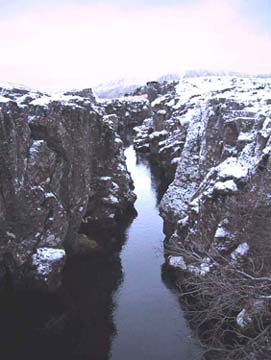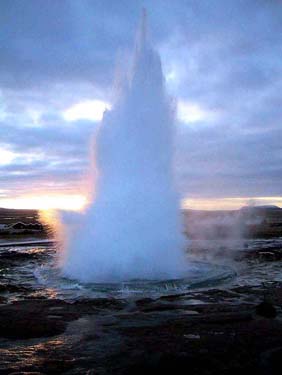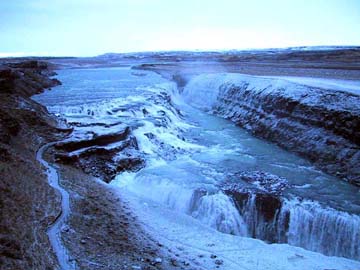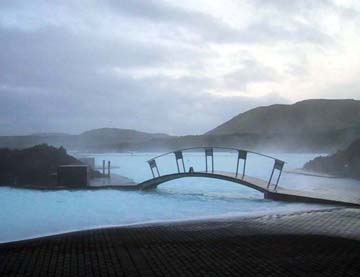Geotimes

Travels
in Geology December
2003
Touring tectonics in Iceland
 Though at first
it may seem off the beaten path, Iceland is an ideal stopover on the way to
Paris or Rome. Icelandair offers an unbeatable deal for travelers en route to
or from mainland Europe or the United Kingdom. At no extra charge, travelers
may stop over in Iceland for up to three nights — enough time to sample
the capital city and tour several geologic must-sees within striking distance
of a comfortable hotel.
Though at first
it may seem off the beaten path, Iceland is an ideal stopover on the way to
Paris or Rome. Icelandair offers an unbeatable deal for travelers en route to
or from mainland Europe or the United Kingdom. At no extra charge, travelers
may stop over in Iceland for up to three nights — enough time to sample
the capital city and tour several geologic must-sees within striking distance
of a comfortable hotel.
Iceland has spent the past decade promoting an effective campaign encouraging
tourism from abroad. While many Americans were happy enough to listen to rockers
Björk and Sigur Rós, few had contemplated visiting the North Atlantic
nation until the pervasive advertising began. Reykjavík has developed
into a chic capital, renowned for its café culture, nightlife, fine arts
and popular music. It has rightly billed itself as a hip European city within
striking distance of the U.S. East Coast and it is becoming a standard destination
for global travelers. The country's geological attractions though, have always
been good reasons to visit Iceland; the recent deals associated with the tourism
campaign are only icing on the geologist's cake.
The Mid-Atlantic spreading center rises
above sea level at Thingvellir, Iceland. The left side of the photograph is
the North American tectonic plate and the right side is the Eurasian tectonic
plate. All images by Callan Bentley.
No trip to Iceland would be complete without visiting the only spot in the
world where you can stand on the mid-ocean ridge without a wetsuit. At Thingvellir,
the Mid-Atlantic Ridge rises above sea level. Historians know the site for an
A.D. 930 meeting of Iceland's version of the Continental Congress, which set
down the laws for ancient Icelanders. This human history pales, however, in
comparison to the topographic setting. Geologists will awe at Thingvellir's
numerous parallel chasms. Half of Iceland is heading east; half of Iceland is
heading west. It is a thrill of tectonic proportions to walk from the Eurasian
plate to the North American plate. The hike across the spreading center takes
only a few minutes through a landscape of columnar basalt dusted with corn snow,
and water lying clear as gin in the deeper fissures.
Next stop on any geologic adventure should be the country's famed geysers.
From Wyoming's Yellowstone to New Zealand's Rotorua, every spouting hot spring
in the world is named for Iceland's Geysir — a steaming pool in the Haukadalur
Valley, a few hours' drive from Reykjavik. Pronounced "gay-zeer,"
this original geyser (the word the English language co-opted from Icelandic)
means "the gusher." Like geysers everywhere, it is a hot spring with
an underground chamber. Subterranean magma heats water until it reaches a flashpoint.
In a sudden boiling conversion, deep steam expands and drives overlying water
up through a fissure in the surface. The release of pressure triggers a further
conversion of hot water to steam, and the eruption is thus a positive-feedback
loop — vaporizing a great deal of groundwater. Fountains of boiling water
and steam shoot high in the air.
 Geysir has been
erupting since the 13th century. In its heyday, these eruptions reached heights
of 60 meters. However, in the early part of the 20th century, the eruptions
became more and more irregular and ceased altogether in 1916. In the less-environmentally
aware days that followed, people could coax Geysir into eruption by dumping
carbolic soap into the pool; but this practice is currently out of vogue. Now,
Geysir sits gently steaming next to a large boulder chiseled with its name —
almost a tombstone for the geyser, given its dormant state.
Geysir has been
erupting since the 13th century. In its heyday, these eruptions reached heights
of 60 meters. However, in the early part of the 20th century, the eruptions
became more and more irregular and ceased altogether in 1916. In the less-environmentally
aware days that followed, people could coax Geysir into eruption by dumping
carbolic soap into the pool; but this practice is currently out of vogue. Now,
Geysir sits gently steaming next to a large boulder chiseled with its name —
almost a tombstone for the geyser, given its dormant state.
Fortunately for Haukadalur tourism, Geysir is not the valley's only geothermal
feature. A short stroll away from the deflated "father" of geysers
is the yet-virile Strokkur. Depending on your translator, Strokkur means
"the churn" or "the piston." It erupts every eight minutes
or so, with an obelisk of steam and water reaching 30 meters high. Due to few
visitors and easy access, it is far more impressive than Yellowstone's prized
Old Faithful. Unlike at Old Faithful, visitors can walk right up to the lip
of Strokkur. As the eruption begins, there is a slight whirlpool effect, and
the pool's water level falls as in a flushing toilet basin. Then a dome of aquamarine
water bulges up from the center, 2 meters in diameter and 0.5 meters tall. Viewers
only get a brief glimpse of this gem; it exists for perhaps half a second, and
then is pierced from within by a vertical jet of steam. After the water collapses
again to the ground, the steam hangs in the air like a retinal after-image,
dissipating slowly.
Every eight minutes, the geyser Strokkur
erupts a column of boiling water and steam to heights of 30 meters.
 Not far from
Geysir is Gullfoss, a bi-level waterfall, located in a deep canyon on the Hvitá
River. Hvítá means "White" in Icelandic. Here,
water plummets a total of 32 meters in two perpendicular ledges. Gullfoss would
be fantastic enough if it were only one falls, but having two ledges in such
close proximity lends a geometric M.C. Escher effect to the scene. The river's
torrent plunges over the upper falls, makes a 90 degree turn to the left, plunges
over the lower falls, and makes a 90 degree turn to the right. Mist drifts up
from the falls to several viewpoints situated along the chasm's edge. It deposits
a shadowlike edge of ice on the riverward faces of guardrails, cliffs and any
tourist who stands there gawking too long.
Not far from
Geysir is Gullfoss, a bi-level waterfall, located in a deep canyon on the Hvitá
River. Hvítá means "White" in Icelandic. Here,
water plummets a total of 32 meters in two perpendicular ledges. Gullfoss would
be fantastic enough if it were only one falls, but having two ledges in such
close proximity lends a geometric M.C. Escher effect to the scene. The river's
torrent plunges over the upper falls, makes a 90 degree turn to the left, plunges
over the lower falls, and makes a 90 degree turn to the right. Mist drifts up
from the falls to several viewpoints situated along the chasm's edge. It deposits
a shadowlike edge of ice on the riverward faces of guardrails, cliffs and any
tourist who stands there gawking too long.
At the spectacular Gullfoss waterfall, two ledges at right angles drop the Hvítá
River a total of 32 meters.
Round out your Icelandic tour at the Blue Lagoon, a geothermal spa near Keflavík.
Here, opaque turquoise waters steam in the midst of a dark bouldery basalt flow.
Iceland's promotional literature typically features bikini-clad Scandanavians
with white mud masks lounging in this surreal setting. Although the Blue Lagoon
is not a natural phenomenon, its origin is in Iceland's use of geothermal power.
The nearby Svartsengi power plant, industrially venting steam in the visible
distance, is fuelled by geothermally warmed seawater. The plant dumped its effluent
into the empty lava field, but dissolved minerals precipitated and sealed the
cracks in the basalt, forming an unintended pool of pale azure brine. The spa's
distinct color is attributed to cyanobacteria (blue-green algae) that live in
the hot water.
 The elegant bathhouse
building includes changing rooms, a restaurant and a skin-care products shop.
Iceland prides itself on bold architecture, and the Blue Lagoon facility is
no exception. Japanese-style footbridges combine with blond wood and a sweeping
glass wall to create an impressive structure. From the changing room, bathers
enter the Blue Lagoon indoors. They push open a submerged door to exit into
the pool proper. It is a wonderful sensation to glide through the dense (2.5
percent salt) water, surrounded by piles of lichen-encrusted basalt. Because
of the water's opacity (visibility is approximately the same as in latex paint),
bathers must gingerly grope forward with their toes as advance feelers. Visitors
also lather their faces with silica mud, although there seems to be little benefit
aside from amusing other bathers. After an hour or two, wrinkled as prunes,
bathers head back inside for a requisite shower (lest the hair petrify into
a geological formation of its own), a Viking beer and a bowl of plokkfiskur
fish soup or a set of diminutive puffin steaks.
The elegant bathhouse
building includes changing rooms, a restaurant and a skin-care products shop.
Iceland prides itself on bold architecture, and the Blue Lagoon facility is
no exception. Japanese-style footbridges combine with blond wood and a sweeping
glass wall to create an impressive structure. From the changing room, bathers
enter the Blue Lagoon indoors. They push open a submerged door to exit into
the pool proper. It is a wonderful sensation to glide through the dense (2.5
percent salt) water, surrounded by piles of lichen-encrusted basalt. Because
of the water's opacity (visibility is approximately the same as in latex paint),
bathers must gingerly grope forward with their toes as advance feelers. Visitors
also lather their faces with silica mud, although there seems to be little benefit
aside from amusing other bathers. After an hour or two, wrinkled as prunes,
bathers head back inside for a requisite shower (lest the hair petrify into
a geological formation of its own), a Viking beer and a bowl of plokkfiskur
fish soup or a set of diminutive puffin steaks.
A footbridge traverses the tuquoise waters
of Keflavík's Blue Lagoon.
The Blue Lagoon is a short drive from the Keflavík International Airport,
also an architectural masterwork and the hub of Icelandair's trans-Atlantic
fleet. If you don't have three days, another airline promotional feature allows
a stopover of only four hours for the sake of visiting the Blue Lagoon. Travelers
may arrive from Glasgow, Paris or Stockholm, pop through Customs with merely
a bathing suit and a towel, have a lapis-tinted soak, then head back for their
connecting flight to Baltimore, New York or Boston.
Callan Bentley
Geotimes contributing writer
Links:
More about the
Blue Lagoon
More about Thingvellir
More about Geysir
Icelandair
Read
more Travels
in Geology.
Back to top
 Though at first
it may seem off the beaten path, Iceland is an ideal stopover on the way to
Paris or Rome. Icelandair offers an unbeatable deal for travelers en route to
or from mainland Europe or the United Kingdom. At no extra charge, travelers
may stop over in Iceland for up to three nights — enough time to sample
the capital city and tour several geologic must-sees within striking distance
of a comfortable hotel.
Though at first
it may seem off the beaten path, Iceland is an ideal stopover on the way to
Paris or Rome. Icelandair offers an unbeatable deal for travelers en route to
or from mainland Europe or the United Kingdom. At no extra charge, travelers
may stop over in Iceland for up to three nights — enough time to sample
the capital city and tour several geologic must-sees within striking distance
of a comfortable hotel.
 Geysir has been
erupting since the 13th century. In its heyday, these eruptions reached heights
of 60 meters. However, in the early part of the 20th century, the eruptions
became more and more irregular and ceased altogether in 1916. In the less-environmentally
aware days that followed, people could coax Geysir into eruption by dumping
carbolic soap into the pool; but this practice is currently out of vogue. Now,
Geysir sits gently steaming next to a large boulder chiseled with its name —
almost a tombstone for the geyser, given its dormant state.
Geysir has been
erupting since the 13th century. In its heyday, these eruptions reached heights
of 60 meters. However, in the early part of the 20th century, the eruptions
became more and more irregular and ceased altogether in 1916. In the less-environmentally
aware days that followed, people could coax Geysir into eruption by dumping
carbolic soap into the pool; but this practice is currently out of vogue. Now,
Geysir sits gently steaming next to a large boulder chiseled with its name —
almost a tombstone for the geyser, given its dormant state. Not far from
Geysir is Gullfoss, a bi-level waterfall, located in a deep canyon on the Hvitá
River. Hvítá means "White" in Icelandic. Here,
water plummets a total of 32 meters in two perpendicular ledges. Gullfoss would
be fantastic enough if it were only one falls, but having two ledges in such
close proximity lends a geometric M.C. Escher effect to the scene. The river's
torrent plunges over the upper falls, makes a 90 degree turn to the left, plunges
over the lower falls, and makes a 90 degree turn to the right. Mist drifts up
from the falls to several viewpoints situated along the chasm's edge. It deposits
a shadowlike edge of ice on the riverward faces of guardrails, cliffs and any
tourist who stands there gawking too long.
Not far from
Geysir is Gullfoss, a bi-level waterfall, located in a deep canyon on the Hvitá
River. Hvítá means "White" in Icelandic. Here,
water plummets a total of 32 meters in two perpendicular ledges. Gullfoss would
be fantastic enough if it were only one falls, but having two ledges in such
close proximity lends a geometric M.C. Escher effect to the scene. The river's
torrent plunges over the upper falls, makes a 90 degree turn to the left, plunges
over the lower falls, and makes a 90 degree turn to the right. Mist drifts up
from the falls to several viewpoints situated along the chasm's edge. It deposits
a shadowlike edge of ice on the riverward faces of guardrails, cliffs and any
tourist who stands there gawking too long.  The elegant bathhouse
building includes changing rooms, a restaurant and a skin-care products shop.
Iceland prides itself on bold architecture, and the Blue Lagoon facility is
no exception. Japanese-style footbridges combine with blond wood and a sweeping
glass wall to create an impressive structure. From the changing room, bathers
enter the Blue Lagoon indoors. They push open a submerged door to exit into
the pool proper. It is a wonderful sensation to glide through the dense (2.5
percent salt) water, surrounded by piles of lichen-encrusted basalt. Because
of the water's opacity (visibility is approximately the same as in latex paint),
bathers must gingerly grope forward with their toes as advance feelers. Visitors
also lather their faces with silica mud, although there seems to be little benefit
aside from amusing other bathers. After an hour or two, wrinkled as prunes,
bathers head back inside for a requisite shower (lest the hair petrify into
a geological formation of its own), a Viking beer and a bowl of plokkfiskur
fish soup or a set of diminutive puffin steaks.
The elegant bathhouse
building includes changing rooms, a restaurant and a skin-care products shop.
Iceland prides itself on bold architecture, and the Blue Lagoon facility is
no exception. Japanese-style footbridges combine with blond wood and a sweeping
glass wall to create an impressive structure. From the changing room, bathers
enter the Blue Lagoon indoors. They push open a submerged door to exit into
the pool proper. It is a wonderful sensation to glide through the dense (2.5
percent salt) water, surrounded by piles of lichen-encrusted basalt. Because
of the water's opacity (visibility is approximately the same as in latex paint),
bathers must gingerly grope forward with their toes as advance feelers. Visitors
also lather their faces with silica mud, although there seems to be little benefit
aside from amusing other bathers. After an hour or two, wrinkled as prunes,
bathers head back inside for a requisite shower (lest the hair petrify into
a geological formation of its own), a Viking beer and a bowl of plokkfiskur
fish soup or a set of diminutive puffin steaks.